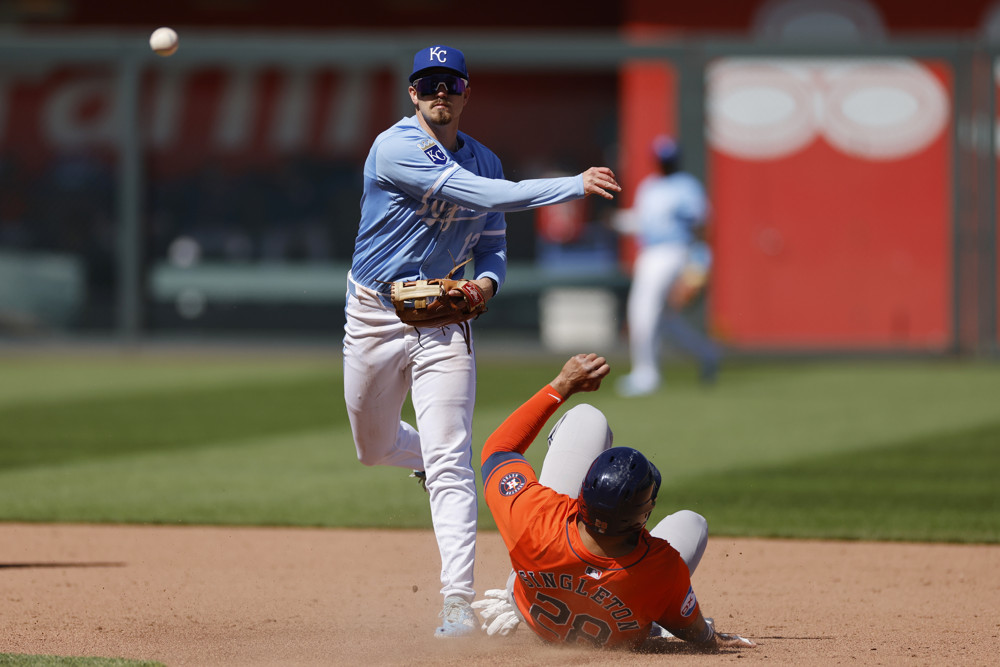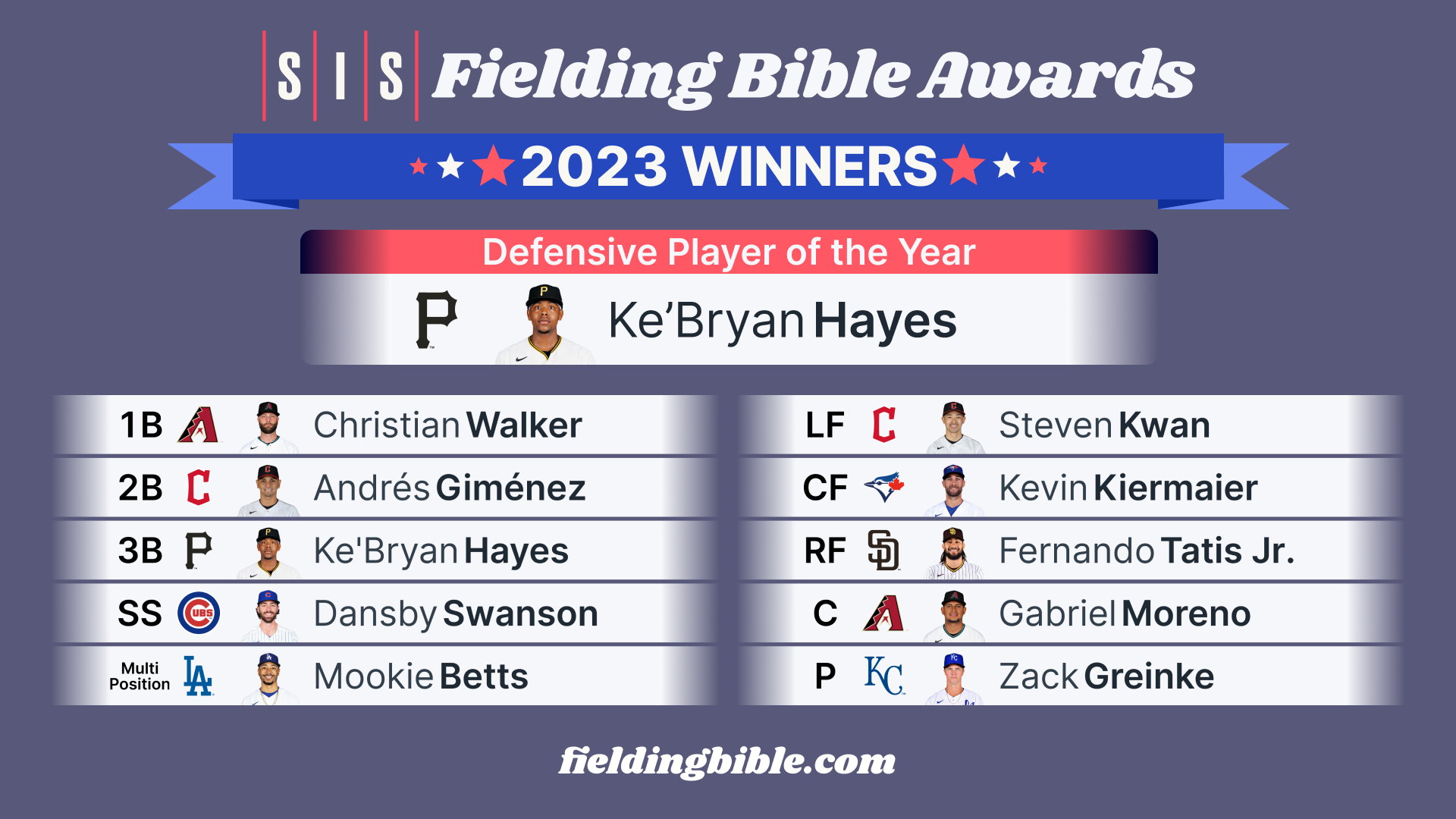Photo by John Rivera/Icon Sportswire
University of Kansas baseball coach Dan Fitzgerald remembers reading Moneyball in one sitting the night he bought the book.
He would go to football games and notice the different situational packages teams would utilize on defense. When he’d go watch the Dallas Stars play, he took notice of a new approach to defensive zone breakouts.
And he has an appreciation for Lawrence, Kansas, knowing it’s the home of not just the school at which he coaches, but also sabermetric pioneer Bill James.
So with a KU program that finished no better than 5th place in the Big 12 in the last eight seasons, and 20-52 in league play in the last three seasons Fitzgerald knew that to be competitive, he needed to think a little outside the box.
For much of a two-month stretch, Kansas tinkered with how it approached infield defense, The coaching staff had second baseman Kodey Shojinaga and third baseman Michael Brooks flip positions based on whether a left or right-handed hitter was up. Two other infielders, Chase Diggins and Collier Cranford, have also occasionally been parts of defensive shifting. The Jayhawks have had upwards of a couple dozen moves per game in games in which the opponent’s lineup is balanced between left and right-handed hitters.
There is an acknowledgement within the team that Brooks has the best range of their infielders and that actually fits well with Shojinaga, who is versatile enough to play both catcher and shortstop when circumstances dictate but also has the best reactions to catch hard-hit opposite-field line drives.
“We started looking at ground ball profiles of hitters and ground ball profiles of our pitchers, and if so-and-so’s pitching and a left-handed hitter’s up, the range they need to play second base is huge,” Fitzgerald said. “The plays at third base become more standard. If they hit it the other way, they stay on it and scorch it.
“We asked ourselves, if we look at the skill sets of our players and we match them up with the best position they can be in to make a play, and we pretend we’re not stuck to the laws of baseball, what would we do?”
The move didn’t make Kansas a powerhouse, but the Jayhawks did go 15-15 in the Big 12 during the regular season, only the 2nd time in the last 9 seasons that they finished .500 or better in league play. They’re the No. 7 seed in the Big 12 Tournament, which opens Tuesday morning.
Brooks broke his hand in late April and hasn’t played since, so the positional maneuvering is on pause for now. We actually called Fitzgerald just after Brooks got injured and figured we’d share this story even in Brooks’ absence because at SIS, we’re interested in anything that is motivated by the pursuit of defensive excellence.
The origins of this maneuvering date back to Fitzgerald’s days coaching at Dallas Baptist University with head coach Dan Heefner and pitching coach Wes Johnson (former Twins pitching coach and now head coach at Georgia) and Josh Hopper (now the Pirates pitching coordinator).
Fitzgerald also noticed that LSU did something similar last year with middle infielders Jordan Thompson and Gavin Dugas and third baseman Tommy White, largely to protect Dugas’ arm after he returned from a dislocated shoulder.
It makes sense that the roster on Kansas’ website doesn’t list anyone by a specific position. Anyone who plays an infield position is listed simply as “INF.”
“When we recruit them, they’re gonna come in and we’re gonna train them,” Fitzgerald said. “We’re just gonna figure out where they should play after that.”
One aspect of the training is their primary infield drill in which any right-handed throwing infielder takes ground balls all across the diamond multiple times per week.
“If you saw us do our infield work, you’d be like ‘Dude, they never played a position,’” Fitzgerald said. “If you asked our guys, they’d say they’re infielders. They wouldn’t say ‘I play shortstop’ or ‘I play second base.’ I think they all see themselves as combo guards.”
The tinkering is not just limited to infield defense. Fitzgerald has thought about playing a four-man outfield but thinks his outfield is good enough that it isn’t necessary. One recent unusual decision was taking one pitcher and telling him a few weeks ago to throw sidearm. That pitcher is now game ready.
Within the roster itself, there isn’t that much talk about the strategic approach.
“It’s interesting but I don’t mind it,” Brooks said. “I’ve been asked by players on other teams what’s going on here, why do you guys do that? Coach Fitz didn’t even really tell me why we did it but I guess he just trusted and knew that I could do it. Third base is more reaction but if your reaction times are really good then playing up the middle shouldn’t be a problem.
I don’t think anybody cares what’s going on if we’re winning.”
We don’t have any Defensive Runs Saved numbers at the college level that we can share (and the sample size of impacted plays was small relative to the rest of the season), but Kansas’ all-around defense and pitching both improved considerably from 2023. The Jayhawks went from averaging 8.6 runs allowed in Big 12 play last year to 5.5 in 2024.
If you’re wondering about the implementation of this in MLB, it’s not happening. The NCAAA doesn’t have any shift ban rules. But MLB’s new shift ban rules, implemented last season, forbid this, with a memo specifically stipulating “Infielders may not switch sides. In other words, a team cannot reposition its best defender on the side of the infield that the batter is more likely to hit the ball.”
Even if Fitzgerald doesn’t use this strategy again this year, he’s a believer that it worked and that it will be worth doing in the future.
“I’m in on it, man,” Fitzgerald said. “I wish I would have been bolder to do it even sooner because I think it makes sense.”



